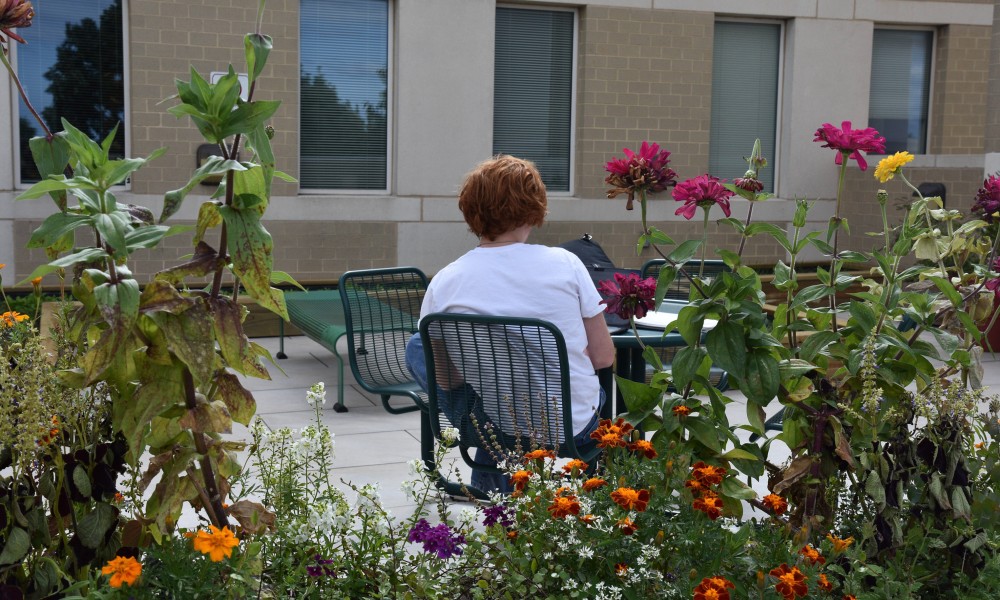Long thyme no see: King Hall’s rooftop garden is in a season of regrowth
News
In the gentle embrace of a crisp morning or the warmth of a sunny afternoon, Geography and Integrated Science and Technology (ISAT) professor Carole Nash can be found nurturing the rooftop garden atop King Hall.
Nash, who has been gardening since childhood, faced a challenge this past summer when JMU decided to renovate the King Hall roofs – disrupting the rooftop garden. Many plants and flowers, including the raised garden beds built by former students, had to be removed and relocated. Some plants were transplanted near the James Madison statue outside King Hall, and others were shared with employees.
When King Hall was built in 1997, the 3rd-floor patio had an open roof, a blank slate of white and beige, and a few tables scattered throughout the space. However, the landscape was transformed in 2012 when a landscape architect suggested converting the open space into a garden.
“The School of Integrated Sciences, particularly ISAT, has always been focused on the idea of sustainability and that there are ways to use spaces so that you can practice environmental sustainability. It just seemed like this (patio) was not being used well,” Nash said.
For 11 years, faculty, staff, and students diligently tended to the rooftop garden, which hosted approximately 150 plant varieties, including perennial flowers. Raised beds were dedicated to growing vegetables, with one remarkable year yielding a harvest of 70 pounds of sweet potatoes. The garden served as an example of an open outdoor space supporting food production and fostering biodiversity.
The renovation allowed Nash, students, staff, and faculty the opportunity to explore new possibilities during this season of regrowth.
Today, the garden is vastly different. JMU’s Facilities Management redesigned and rebuilt the raised garden beds, ensuring accessibility from all sides. They’ve utilized the soil from the old beds and are implementing a new watering system consisting of faucets and drip lines to automate plant watering. Students will have access to fresh fruit and vegetable plants for harvesting as well as a flower and herb garden that includes 30 herb varieties, such as basil and Greek oregano.
This spring, Nash plans to cultivate a variety of crops, including tomatoes, sweet potatoes, lettuce, onions, and spinach. The success of this planting is possible due to cover crops – peas, grasses, and radishes, currently growing in the garden’s raised beds. Nash refers to the cover crops as “nitrogen-fixing plants,” They remain in the ground throughout the winter, processing nitrogen and enriching the soil. This preparation will ensure that the soil will be ready to support new plants in the spring.
“A lot of this is having knowledge of gardening, learning about what you can do up here, and then taking some time to think about what you want to show people, what is possible in a place like this,” Nash said.
Nash encounters some challenges when gardening during peak season – primarily dealing with the heat and strong winds on the rooftop. It is a process of trial and error.
“You can’t just expect things that work down there will work up here,” Nash said.
Much of the growth happens during the summer when students aren’t around to experience it. However, Nash works hard to optimize the learning experience for all JMU students.
Previously, in Nash’s citizen sciences course, students engaged in the “Bugs and Blooms” project. The students learned about a plant’s characteristics, both in and out of bloom, developing an app capable of tracking the timing of blooms in the garden and the presence of pollinators, particularly bees, frequent visitors to the garden. The goal was to compare the timing of the blooms and the arrival of the pollinators. The project aimed to address the effects of climate change, as it’s causing shifts in the timing of blooms and pollinators.
“We want to use this (garden) as a teaching space for urban gardening, for climate change impacts, and to get people to recognize that even if you don’t have nice wooden beds, you can have a pot and grow something in it on your deck,” Nash said.
The garden is not just limited to teaching. It also serves as an outside study space and a picturesque spot to enjoy lunch. Tables and benches are spread throughout the patio, providing students room to sit among the plants.
Lana Cruz, a junior geography major, recently discovered the rooftop garden.
She describes the area as “being outside and seeing a little bit of the view of campus” – her favorite part about studying on the rooftop garden.
As the garden expands, it prompts inquiries and discussions among engaged faculty, staff, and students. Nash contemplates the feasibility of growing additional fruit varieties, dwarf fruit trees, fig trees, and more. She anticipates a promising future for the rooftop garden and the valuable learning experiences it will provide.
The rooftop garden is part of the Campus Environmental Stewardship Tour.
